Characterization of Exhaust CO, HC and NOx Emissions from Light-Duty Vehicles under Real Driving Conditions
Abstract
:1. Introduction
2. Materials and Methods
2.1. Test Vehicles and Routes
2.2. Measurement System
2.3. Data Processing
3. Results and Discussion
3.1. Emission Factors of Regulated Gaseous Pollutants
3.2. Effect of Speed and Acceleration on Emissions
3.3. Emission Characteristics of Pollutants Based on VSP
4. Conclusions
Supplementary Materials
Author Contributions
Funding
Institutional Review Board Statement
Informed Consent Statement
Data Availability Statement
Acknowledgments
Conflicts of Interest
References
- Prakash, S.; Bodisco, T. An investigation into the effect of road gradient and driving style on NOx emissions from a diesel vehicle driven on urban roads. Transp. Res. Part D Transp. Environ. 2019, 72, 220–231. [Google Scholar] [CrossRef]
- Jin, B.; Zhu, R.; Mei, H.; Wang, M.; Zu, L.; Yu, S.; Zhang, R.; Li, S.; Bao, X. Volatile organic compounds from a mixed fleet with numerous E10-fuelled vehicles in a tunnel study in China: Emission characteristics, ozone formation and secondary organic aerosol formation. Environ. Res. 2021, 200, 111463. [Google Scholar] [CrossRef]
- Zhang, S.H.; Peng, D.; Li, Y.; Zu, L.; Fu, M.L.; Yin, H.; Ding, Y. Study on the real-world emissions of rural vehicles on different road types. Environ. Pollut. 2021, 273, 116453. [Google Scholar] [CrossRef] [PubMed]
- Hao, L.; Yin, H.; Wang, J.; Wang, X.; Ge, Y. Potential of big data approach for remote sensing of vehicle exhaust emissions. Sci. Rep. 2021, 11, 1. [Google Scholar] [CrossRef]
- Ministry of Ecology and Environment of the People’s Republic of China (MEEPRC). China Mobile Source Environmental Management Annual Report; Ministry of Ecology and Environment of the People’s Republic of China (MEEPRC): Beijing, China, 2020. (In Chinese)
- Zhang, Q.; Wu, L.; Fang, X.; Liu, M.; Zhang, J.; Shao, M.; Lu, S.; Mao, H. Emission factors of volatile organic compounds (VOCs) based on the detailed vehicle classification in a tunnel study. Sci. Total Environ. 2018, 624, 878–886. [Google Scholar] [CrossRef]
- Smit, R.; Bainbridge, S.; Kennedy, D.; Kingston, P. A decade of measuring on-road vehicle emissions with remote sensing in Australia. Atmos. Environ. 2021, 252, 118317. [Google Scholar] [CrossRef]
- Hao, L.; Yin, H.; Wang, J.; Wang, X.; Ge, Y. Remote sensing of NO emission from light-duty diesel vehicle. Atmos. Environ. 2020, 242, 117799. [Google Scholar] [CrossRef]
- Agarwal, A.K.; Mustafi, N.N. Real-world automotive emissions: Monitoring methodologies, and control measures. Renew. Sustain. Energy Rev. 2021, 137, 110624. [Google Scholar] [CrossRef]
- Khan, T.; Frey, C.H. Comparison of real-world and certification emission rates for light duty gasoline vehicles. Sci. Total Environ. 2018, 622–623, 790–800. [Google Scholar] [CrossRef]
- Alves, C.A.; Oliveira, C.; Martins, N.; Mirante, F.; Caseiro, A.; Pio, C.; Matos, M.; Silva, H.F.; Oliverira, C.; Camoes, F. Road tunnel, roadside, and urban background measurements of aliphatic compounds in size-segregated particulate matter. Atmos. Res. 2016, 168, 139–148. [Google Scholar] [CrossRef]
- Real-Driving Emissions Test Procedure for Exhaust Gas Pollutions of CARS and Light Commercial Vehicles in Europe. Available online: https://theicct.org/sites/default/files/publications/EU-RDE_policy-update_18012017_vF.pdf (accessed on 26 August 2021).
- Huang, Y.; Organ, B.; Zhou, J.L.; Surawski, N.C.; Hong, G.; Chan, E.F.; Yam, Y.S. Emission measurement of diesel vehicles in Hong Kong through on-road remote sensing: Performance review and identification of high-emitters. Environ. Pollut. 2018, 237, 133–142. [Google Scholar] [CrossRef]
- Wang, G.; Cheng, S.; Lang, J.; Li, S.; Tian, L. On-board measurements of gaseous pollutant emission characteristics under real driving conditions from light-duty diesel vehicles in Chinese cities. J. Environ. Sci. 2016, 46, 28–37. [Google Scholar] [CrossRef] [PubMed]
- Varella, R.A.; Faria, M.V.; Villafuerte, P.M.; Baptista, P.C.; Sousa, L.; Duarte, G.O. Assessing the influence of boundary conditions, driving behavior and data analysis methods on real driving CO2 and NOx emissions. Sci. Total Environ. 2019, 658, 879–894. [Google Scholar] [CrossRef]
- Duarte, G.O.; Gonçalves, G.A.; Farias, T.L. Analysis of fuel consumption and pollutant emissions of regulated and alternative driving cycles based on real-world measurements. Transp. Res. Part D Transp. Environ. 2016, 44, 43–54. [Google Scholar] [CrossRef]
- Wang, M.L.; Li, S.Y.; Zhu, R.C.; Zu, L.; Wang, Y.J.; Bao, X.F. On-road tailpipe emission characteristics and ozone formation potentials of VOCs from gasoline, diesel and liquefied petroleum gas fueled vehicles. Atmos. Environ. 2020, 223, 117294. [Google Scholar] [CrossRef]
- García, R.; Soriano, J.A.; Fernández, P. Impact of regulated pollutant emissions of Euro 6d-Temp light-duty diesel vehicles under real driving conditions. J. Clean. Prod. 2021, 268, 124927. [Google Scholar] [CrossRef]
- Chaa, J.; Leeb, J.; Chon, M.S. Evaluation of real driving emissions for Euro 6 light-duty diesel vehicles equipped with LNT and SCR on domestic sales in Korea. Atmos. Environ. 2019, 196, 133–142. [Google Scholar] [CrossRef]
- Washburn, S.; Seet, J.; Mannering, F. Statistical modeling of vehicle emissions from inspection/maintenance testing data: An exploratory analysis. Transp. Res. Part D Transp. Environ. 2001, 6, 21–36. [Google Scholar] [CrossRef]
- Zhao, Y.; Lamber, A.T.; Saleh, R.; Saliba, G.; Robinson, A.L. Secondary organic aerosol production from gasoline vehicle exhaust: Effects of engine technology, cold start, and emission certification standard. Environ. Sci. Technol. 2018, 52, 1253–1261. [Google Scholar] [CrossRef] [PubMed]
- Zhu, R.C.; Hu, J.N.; He, L.Q.; Zu, L.; Bao, X.F.; Lai, Y.T.; Su, S. Effects of ambient temperature on regulated gaseous and particulate emissions from gasoline-, E10- and M15-fueled vehicles. Front. Environ. Sci. Eng. 2021, 15, 14. [Google Scholar] [CrossRef]
- Boroujeni, B.Y.; Frey, H.C. Road grade quantification based on global positioning system data obtained from real-world vehicle fuel use and emissions measurements. Atmos. Environ. 2014, 85, 179–186. [Google Scholar] [CrossRef]
- Zhang, Q.; Fan, J.; Yang, W.; Chen, B.; Zhang, L.; Liu, J.; Wang, J.; Zhou, C.; Chen, X. The effects of deterioration and technological levels on pollutant emission factors for gasoline light-duty trucks. J. Air Waste Manag. Assoc. 2017, 67, 814–823. [Google Scholar] [CrossRef] [Green Version]
- Huo, H.; Zheng, B.; Wang, M.; Zhang, Q.; He, K. Vehicular air pollutant emissions in China: Evaluation of past control policies and future perspectives. Mitig. Adapt. Strat Gl. 2015, 20, 719–733. [Google Scholar] [CrossRef]
- Shukla, A.; Alum, M. Assessment of real world on-road vehicle emissions under dynamic urban traffic conditions in Delhi. Int. J. Urban Sci. 2010, 14, 207–220. [Google Scholar] [CrossRef]
- Zhu, R.C.; Hu, J.N.; Bao, X.F.; He, L.Q.; Lai, Y.T.; Zu, L.; Li, Y.F.; Su, S. Investigation of tailpipe and evaporative emissions from China IV and Tier 2 passenger vehicles with different gasolines. Transp. Res. Part D 2017, 50, 305–315. [Google Scholar] [CrossRef]
- Chen, C.; Huang, C.; Jing, Q.; Wang, H.; Pan, H.; Li, L.; Zhao, J.; Dai, Y.; Huang, H.; Schipper, L.; et al. On-road emission characteristics of heavy-duty diesel vehicles in Shanghai. Atmos. Environ. 2007, 41, 5334–5344. [Google Scholar] [CrossRef]
- Andre, M.; Rapone, M. Analysis and modelling of the pollutant emissions from European cars regarding the driving characteristics and test cycles. Atmos. Environ. 2009, 43, 986–995. [Google Scholar] [CrossRef]
- Official Journal of the European Union. Available online: https://eur-lex.europa.eu/legal-content/EN/TXT/PDF/?uri=CELEX:32018R1832&from=FR (accessed on 26 June 2021).
- Jiménez-Palacios, J. Understanding and Quantifying Motor Vehicle Emissions with Vehicle Specific Power and TILDAS Remote Sensing. Ph.D. Thesis, Massachusetts Institute of Technology, Department of Mechanical Engineering, Cambridge, MA, USA, 1999. [Google Scholar]
- Zhai, H.B.; Frey, H.C.; Rouphail, H.M. A vehicle-specific power approach to speed- and facility-specific emissions estimates for diesel transient buses. Environ. Sci. Technol. 2008, 42, 7985–7991. [Google Scholar] [CrossRef]
- Rhys-Tyler, G.A.; Bell, M.C. Toward reconciling instantaneous roadside measurements of light duty vehicle exhaust emissions with type approval driving cycles. Environ. Sci. Technol. 2012, 46, 10238–10532. [Google Scholar] [CrossRef] [Green Version]
- Wang, J.G.; Gui, H.Q.; Yang, Z.W.; Yu, T.Z.; Zhang, X.W.; Liu, J.G. Real-world gaseous emission characteristics of natural gas heavy-duty sanitation trucks. J. Environ. Sci. 2020, 115, 319–329. [Google Scholar] [CrossRef]
- Wan, X.; Song, G.H.; Zhai, Z.Q.; Wu, Y.Z.; Yin, H.; Yu, L. Effects of vehicle load on emissions of heavy-duty diesel trucks: A study based on real-world data. Int. J. Environ. Res. Public Health 2021, 18, 3877. [Google Scholar]
- Zhang, S.H.; Yu, L.; Song, G.H. Emissions characteristics for heavy-duty diesel trucks under different loads based on vehicle-specific power. Transp. Res. Rec. 2017, 2027, 77–85. [Google Scholar] [CrossRef]
- Wang, H.H.; Ge, Y.S.; Tan, J.W.; Wu, L.G.; Wu, P.C.; Hao, L.J.; Peng, Z.H.; Zhang, C.Z.; Wang, X.; Han, Y.X.; et al. The Real-world emissions from urban freight trucks in Beijing. Aerosol. Air Qual. Res. 2018, 18, 1448–1456. [Google Scholar] [CrossRef]
- Perugu, H. Emission modelling of light-duty vehicles in India using the revamped VSP-based MOVES model: The case study of Hyderabad. Transp. Res. Part D. 2019, 68, 150–163. [Google Scholar] [CrossRef]
- Duarte, G.O.; Goncalves, G.A.; Baptista, P.C.; Farias, T.L. Establishing bonds between vehicle certification data and real-world vehicle fuel consumption—A Vehicle Specific Power approach. Energy Convers. Manag. 2015, 92, 251–265. [Google Scholar] [CrossRef]
- He, L.Q.; Hu, J.N.; Yang, L.H.Z.; Li, Z.H.; Zheng, X.; Xie, S.X.; Zu, L.; Chen, J.H.; Li, Y.; Wu, Y. Real-world gaseous emissions of high-mileage taxi fleets in China. Sci. Total Environ. 2019, 659, 267–274. [Google Scholar] [CrossRef]
- Gallus, J.; Kirchner, U.; Vogt, R.; Benter, T. Impact of driving style and road grade on gaseous exhaust emissions of passenger vehicles measured by a Portable Emission Measurement System (PEMS). Transp. Res. Part D Transp. Environ. 2017, 52, 215–226. [Google Scholar] [CrossRef]
- Frey, H.; Unal, A.; Chen, J.; Li, S.; Xuan, C. Methodology for Developing Modal Emission Rates for EPA’s Multi-Scale Motor Vehicle & Equipment Emission System; EPA420-R02-027; U.S. Environmental Protection Agency: Washington, DC, USA, 2002. [Google Scholar]
- Choudhary, A.; Gokhale, S. Urban real-world driving traffic emissions during interruption and congestion. Transp. Res. Part D Transp. Environ. 2016, 43, 59–70. [Google Scholar] [CrossRef]
- Huang, C.; Lou, D.M.; Hu, Z.Y.; Feng, Q.; Chen, Y.R.; Chen, C.H.; Tan, P.Q.; Yao, D. A PEMS study of the emissions of gaseous pollutants and ultrafine particles from gasoline- and diesel-fueled vehicles. Atmos. Environ. 2013, 77, 703–710. [Google Scholar] [CrossRef]
- Mahesh, S.; Ramadurai, G.; Nagendra, S.M.S. Real-world emissions of gaseous pollutants from diesel passenger cars using portable emission measurement systems. Sustain. Cities Soc. 2018, 41, 104–113. [Google Scholar] [CrossRef]
- Lee, Y.; Lee, S.; Lee, S.; Choi, H.; Min, K. Characteristics of NOx emission of light-duty diesel vehicle with LNT and SCR system by season and RDE phase. Sci. Total Environ. 2021, 782, 146750. [Google Scholar] [CrossRef]
- Park, J.; Shin, M.; Lee, J.; Lee, J. Estimating the effectiveness of vehicle emission regulations for reducing NOx from light-duty vehicles in Korea using on-road measurements. Sci. Total Environ. 2021, 767, 144250. [Google Scholar] [CrossRef] [PubMed]
- Carslaw, D.C.; Priestman, M.; Williams, M.L.; Stewart, G.B.; Beevers, S.D. Performance of optimised SCR retrofit buses under urban driving and controlled conditions. Atmos. Environ. 2015, 105, 70–77. [Google Scholar] [CrossRef]
- Wang, X.; Yin, H.; Ge, Y.S.; Yu, L.X.; Xu, Z.X.; Yu, C.L.; Shi, X.J.; Liu, H.K. On-vehicle emission measurement of a light-duty diesel van at various speeds at high altitude. Atmos. Environ. 2013, 81, 263–269. [Google Scholar] [CrossRef]
- Tu, R.; Xu, J.S.; Wang, X.; Zhai, Z.Q.; Hatzopoulou, M. Effects of ambient temperature and cold starts on excess NOx emissions in a gasoline direct injection vehicle. Sci. Total Environ. 2021, 760, 143402. [Google Scholar] [CrossRef] [PubMed]
- Jin, B.Q.; Wang, M.L.; Zhu, R.C.; Jia, M.; Wang, Y.J.; Li, S.Y.; Bao, X.F. Evaluation of additives used in gasoline vehicles in China: Fuel economy, regulated gaseous pollutants and volatile organic compounds based on both chassis dynamometer and on-road tests. Clean Technol. Environ. Policy 2021. [Google Scholar] [CrossRef]
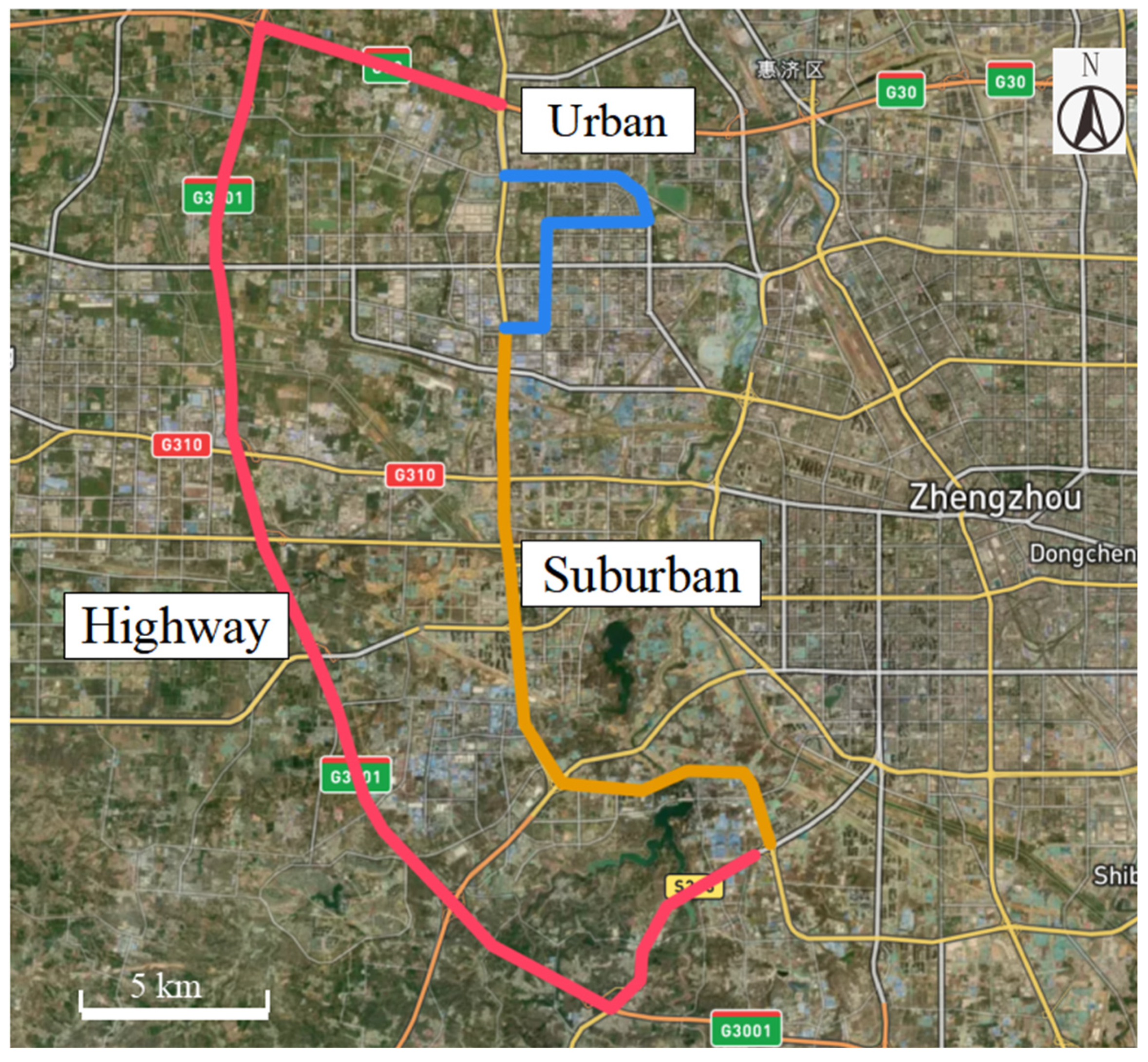
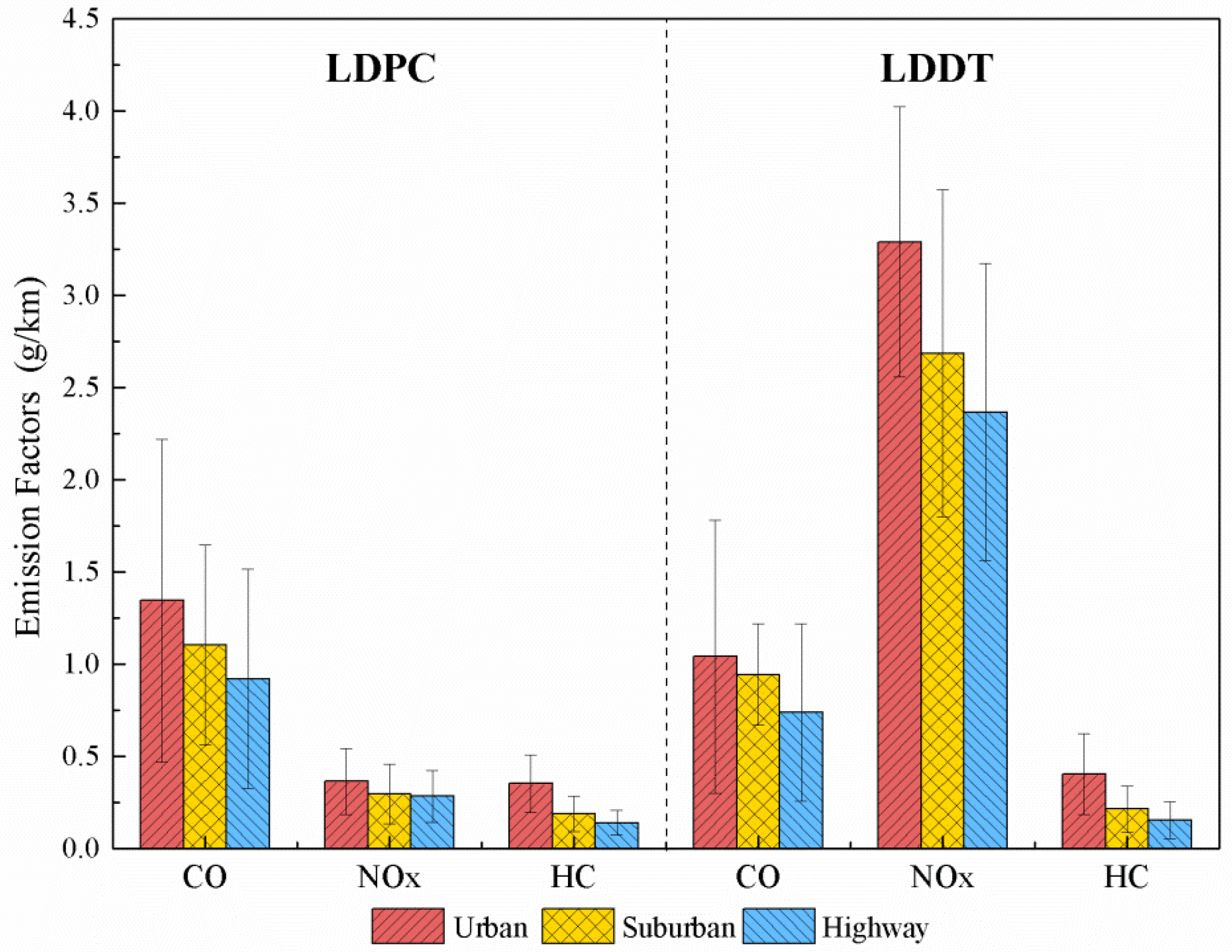
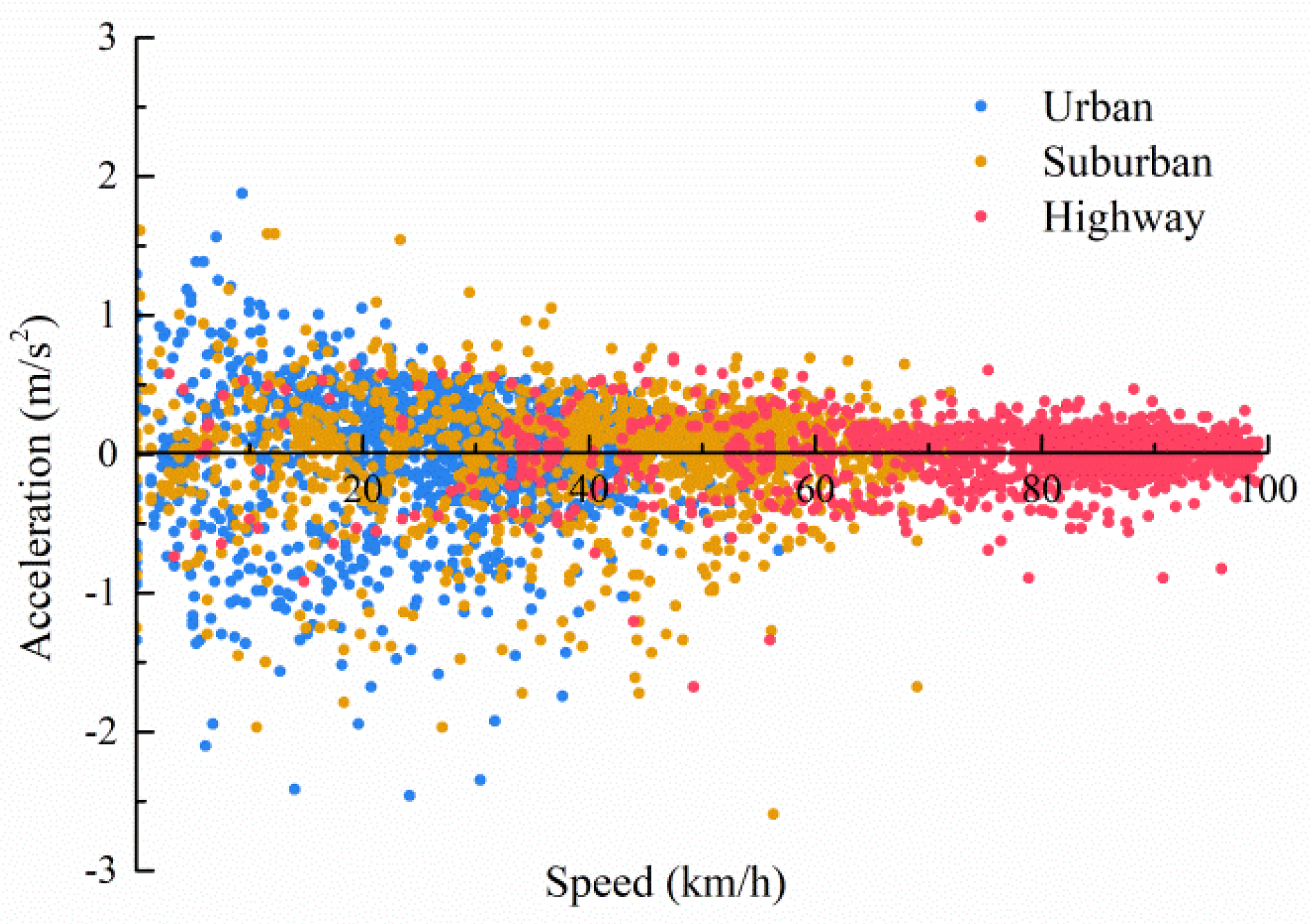
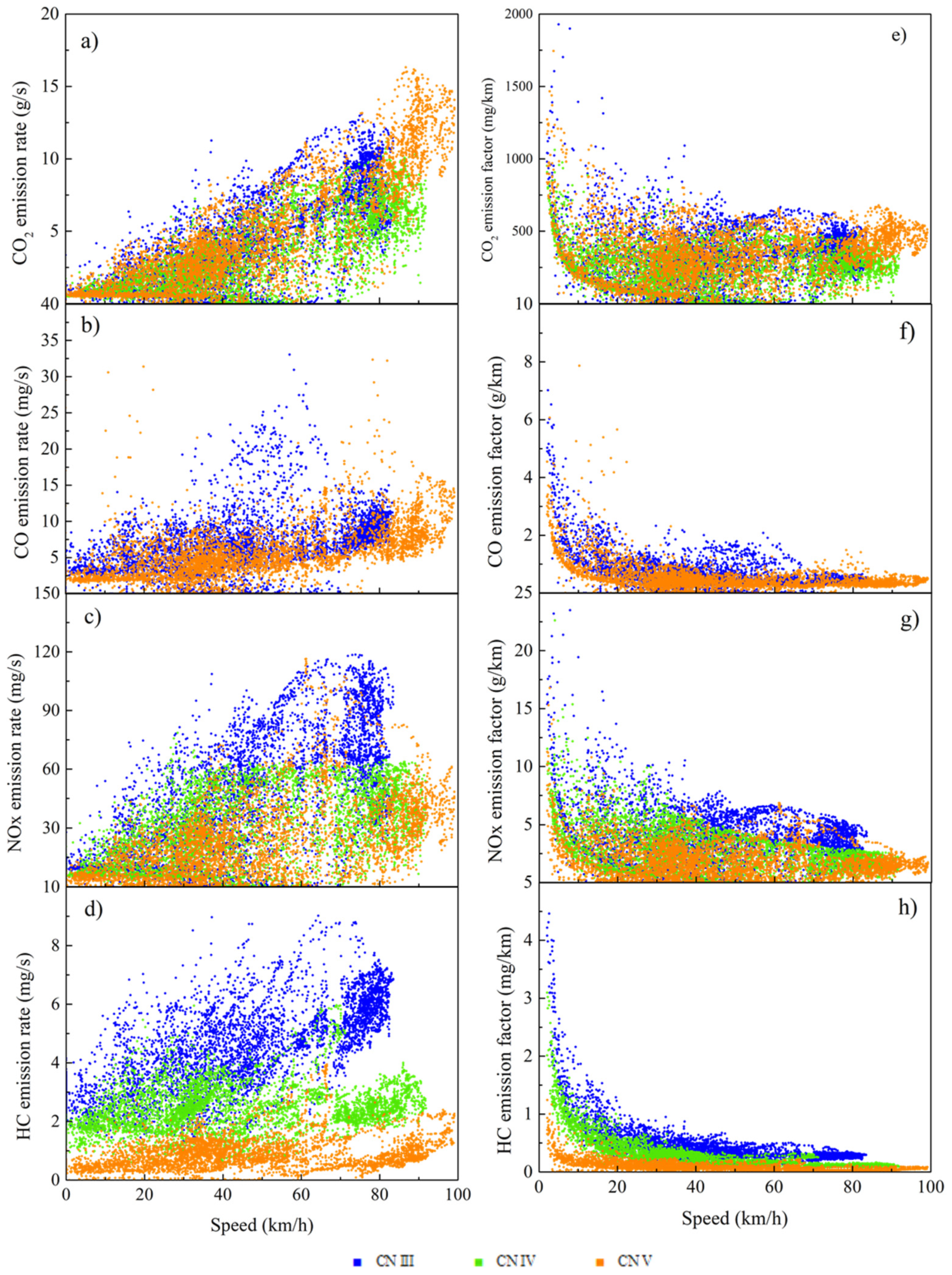
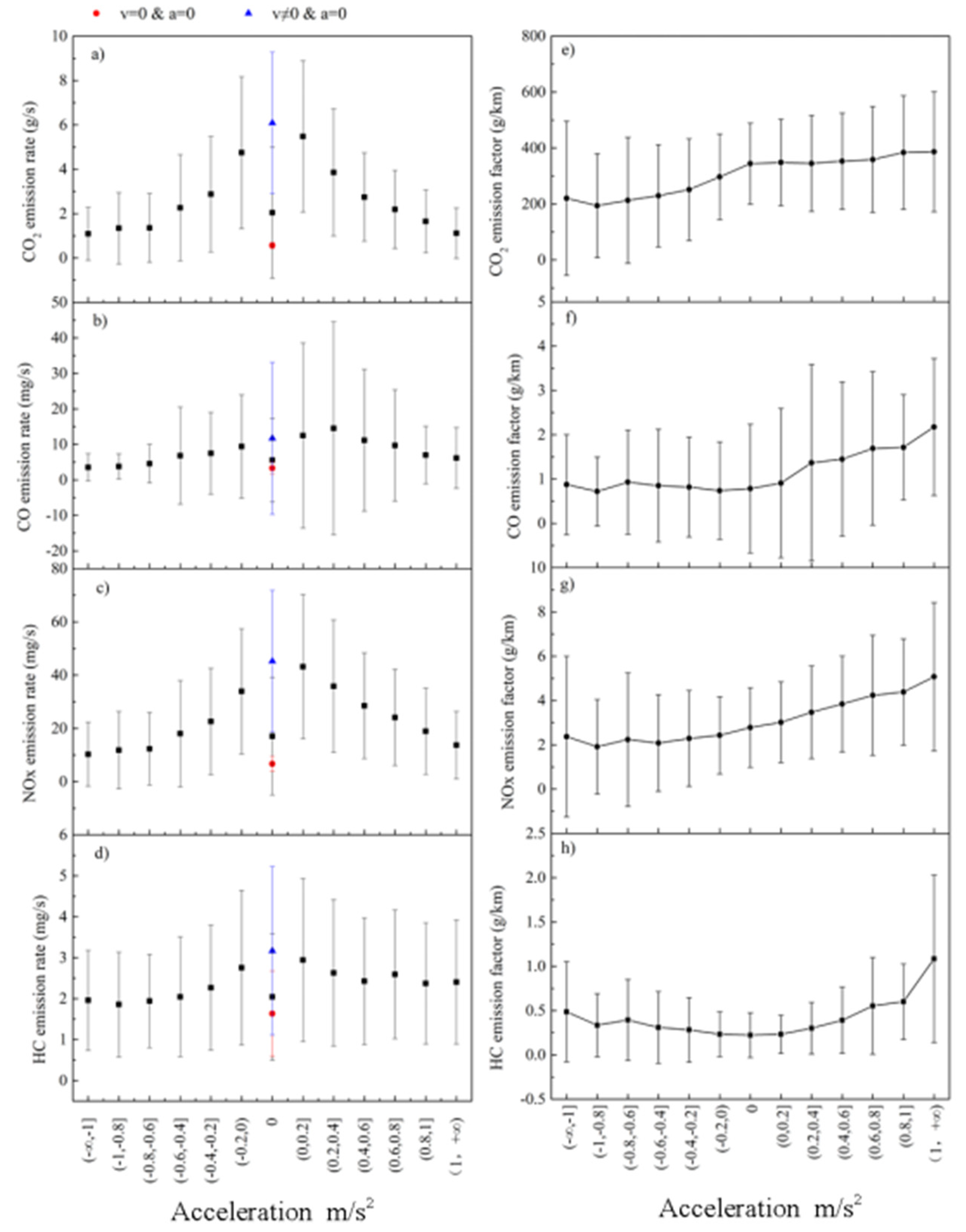
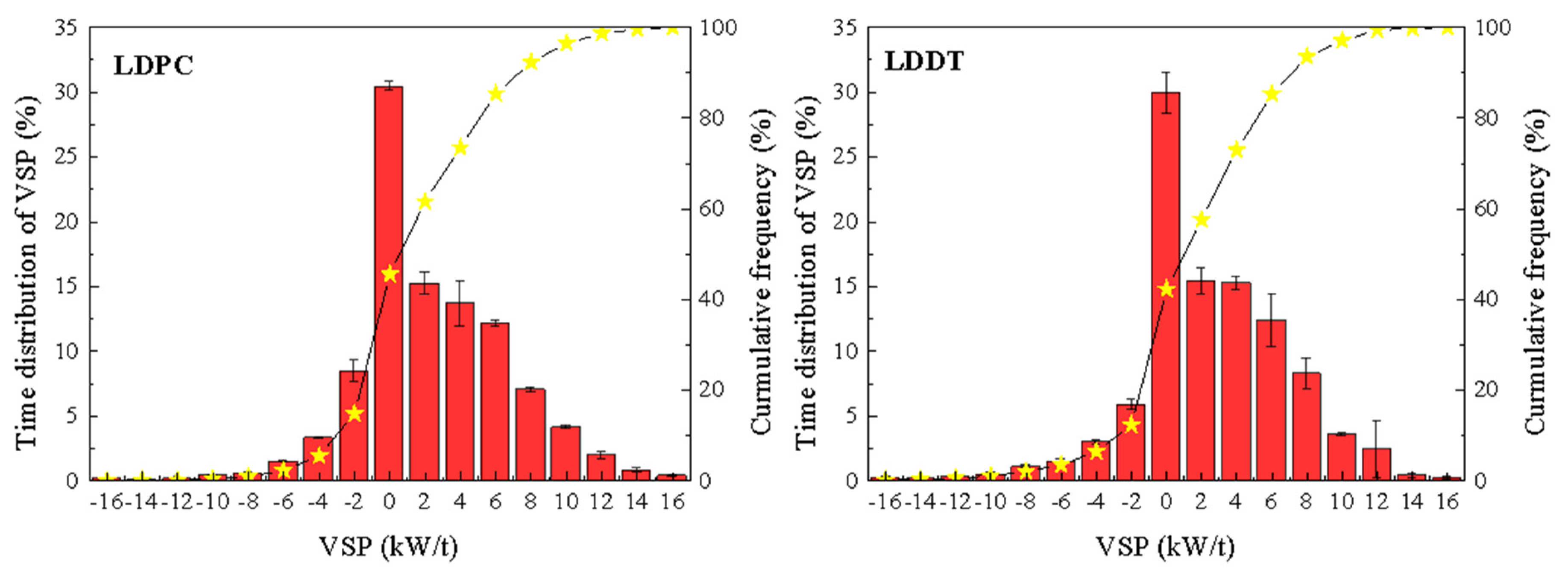
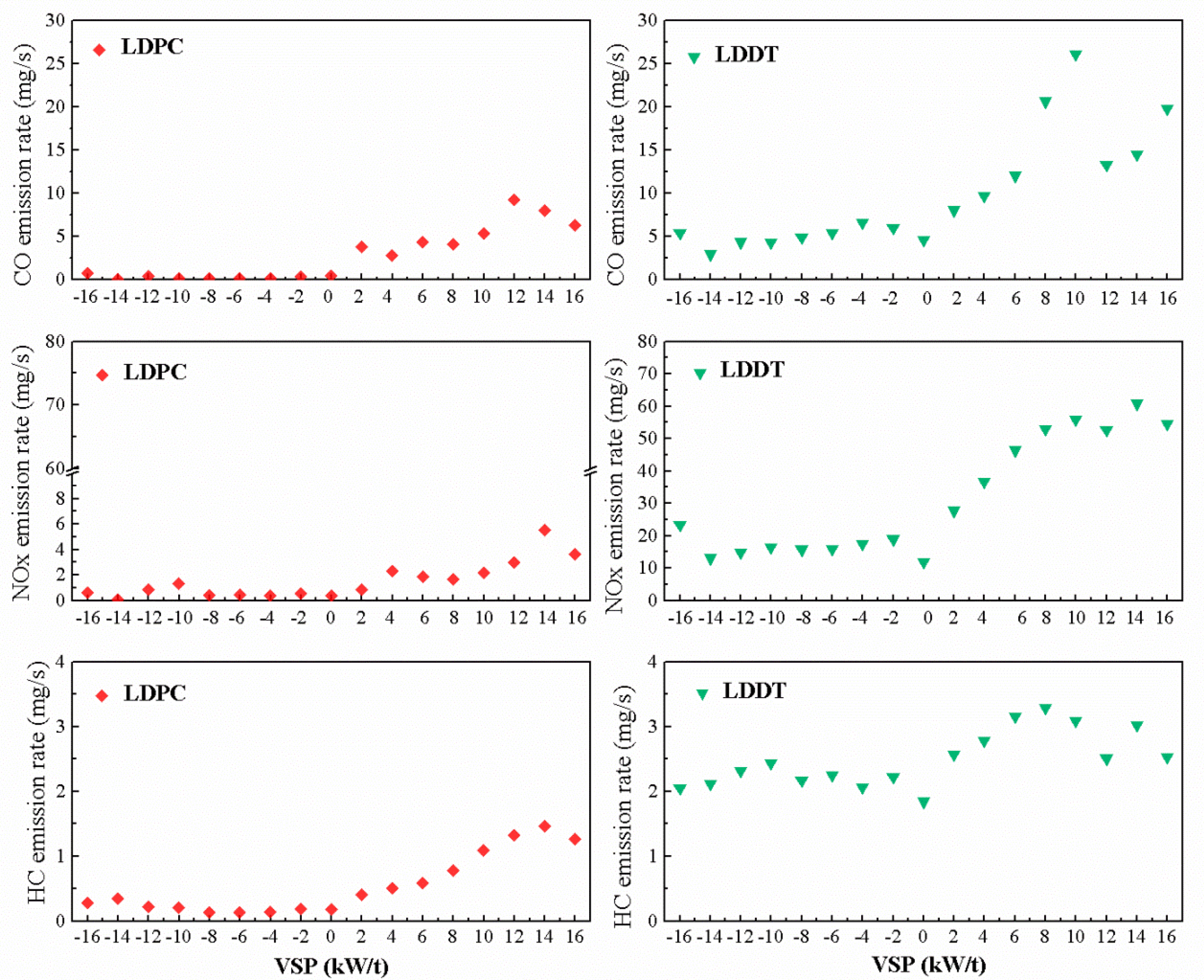
| Label | Fuel | Curb Weight (kg) | Modal Year | Engine Capacity (mL) | Odometer (km) | Emission Standards | After-Treatment | Vehicle Brand |
|---|---|---|---|---|---|---|---|---|
| LDPC1 | Gasoline | 1775 | 2016 | 1600 | 59,784 | China Ⅴ | TWC a | Lavida |
| LDPC2 | Gasoline | 1750 | 2018 | 1600 | 13,427 | China Ⅴ | TWC | Octavia |
| LDDT1 | Diesel | 4495 | 2013 | 3660 | 94,080 | China Ⅲ | —— | Allroad |
| LDDT2 | Diesel | 4485 | 2016 | 2545 | 28,918 | China Ⅳ | DPF b | Ouling |
| LDDT3 | Diesel | 2017 | 2982 | 25,560 | China Ⅴ | SCR c + DOC d | Dayun |
| VSP Bin Number | VSP (kW/t) | VSP Bin Number | VSP (kW/t) |
|---|---|---|---|
| −16 | VSP < −15 | 2 | 1 < VSP ≤ 3 |
| −14 | −15 < VSP ≤ −13 | 4 | 3 < VSP ≤ 5 |
| −12 | −13 < VSP ≤ −11 | 6 | 5 < VSP ≤ 7 |
| −10 | −11 < VSP ≤ −9 | 8 | 7 < VSP ≤ 9 |
| −8 | −9 < VSP ≤ −7 | 10 | 9 < VSP ≤ 11 |
| −6 | −7 < VSP ≤ −5 | 12 | 11 < VSP ≤ 13 |
| −4 | −5 < VSP ≤ −3 | 14 | 13 < VSP ≤ 15 |
| −2 | −3 < VSP ≤ −1 | 16 | 15 < VSP |
| 0 | −1 < VSP ≤ 1 |
Publisher’s Note: MDPI stays neutral with regard to jurisdictional claims in published maps and institutional affiliations. |
© 2021 by the authors. Licensee MDPI, Basel, Switzerland. This article is an open access article distributed under the terms and conditions of the Creative Commons Attribution (CC BY) license (https://creativecommons.org/licenses/by/4.0/).
Share and Cite
Mei, H.; Wang, L.; Wang, M.; Zhu, R.; Wang, Y.; Li, Y.; Zhang, R.; Wang, B.; Bao, X. Characterization of Exhaust CO, HC and NOx Emissions from Light-Duty Vehicles under Real Driving Conditions. Atmosphere 2021, 12, 1125. https://doi.org/10.3390/atmos12091125
Mei H, Wang L, Wang M, Zhu R, Wang Y, Li Y, Zhang R, Wang B, Bao X. Characterization of Exhaust CO, HC and NOx Emissions from Light-Duty Vehicles under Real Driving Conditions. Atmosphere. 2021; 12(9):1125. https://doi.org/10.3390/atmos12091125
Chicago/Turabian StyleMei, Hui, Lulu Wang, Menglei Wang, Rencheng Zhu, Yunjing Wang, Yi Li, Ruiqin Zhang, Bowen Wang, and Xiaofeng Bao. 2021. "Characterization of Exhaust CO, HC and NOx Emissions from Light-Duty Vehicles under Real Driving Conditions" Atmosphere 12, no. 9: 1125. https://doi.org/10.3390/atmos12091125
APA StyleMei, H., Wang, L., Wang, M., Zhu, R., Wang, Y., Li, Y., Zhang, R., Wang, B., & Bao, X. (2021). Characterization of Exhaust CO, HC and NOx Emissions from Light-Duty Vehicles under Real Driving Conditions. Atmosphere, 12(9), 1125. https://doi.org/10.3390/atmos12091125







